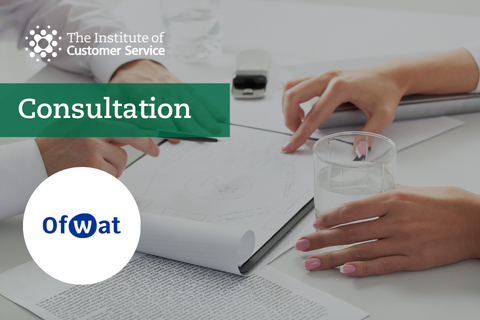The Institute of Customer Service welcomes the opportunity to respond to Ofwat’s consultation on the methodology for PR24. We have a longstanding relationship with Ofwat and some of our independent metrics are already used to help measure performance in the water industry. A number of water companies are members of The Institute, and some have achieved our ServiceMark accreditation.
The ongoing energy and cost of living crisis makes the work of utility regulators, including Ofwat, absolutely critical. Ensuring the UK retains a resilient supply of gas, electricity and water is vital to the ongoing operation and wellbeing of the UK. The responsiveness, understanding and effectiveness of a utility company’s customer service strategy and delivery have never been more vital. Ensuring water companies understand their customers, are responsive to customers’ needs and communicate appropriately using the right channels is therefore essential.
Given the external environment and what has happened over the last three years in particular, trust is a critical aspect of the relationship between organisations and their customers. And because customers cannot move water suppliers, we believe a regulator-driven focus on building trust should be front and centre of water companies’ business plans.
For consumers to trust businesses and be satisfied with the services and products being offered, the water sector must focus on building a culture of service excellence and serving consumers in the right way. This is particularly true for the water sector, where customers have little or no option to switch suppliers potentially leading to greater frustration with no exit route.
To understand what customers want, and where they should invest for the greatest satisfaction gains, water companies should independently survey customers. Internal surveys should also be carried out in order to achieve cultural alignment across the business. Investment in training, development and professionalisation of their customer service staff is also critical. In this way, a virtuous circle can be created with an organisational culture that enables, supports and encourages high levels of customer service standards.
1. Focusing on the long term
A focus on long term objectives will help water companies consistently deliver the best service to customers. To achieve the long term goals, a culture of service excellence needs to permeate the whole business – from front-line customer service staff, to senior leaders.
The Institute’s ServiceMark accreditation provides a framework to develop organisational culture and the behaviours that enable and support high levels of customer service standards. This well-established accreditation is based on a combination of customer feedback, employee feedback and an independent assessment. It gives evidence of an organisation’s commitment to and achievement in customer service. As such, we would suggest for ServiceMark accreditation to be used as a reliable, independent measure to demonstrate commitment to raising customer service standards on an ongoing basis.
2. Reflecting a clearer understanding of customers and their communities
The Institute is clear and agrees that business plans of water companies must be clear and transparent for customers about prices, terms and conditions, as well as any changes made to these. Hidden or unclear costs should also be avoided.
Water companies in particular have a vital role to play in helping their customers to deal with the impacts of price rises where they can, particularly because customers cannot move providers. This should include practical advice about budgeting, ways to save water to reduce costs and flexibility on payment options, where this exists.
However, customers also need to trust that when the cost of their water bill increases, the organisation(s) supplying their home with water are doing all they can to keep prices low, are being clear about changes to the cost of water to customers and are delivering those communications in ways, using language, and via channels that work for the customer. Companies should also allow for two-way dialogue where necessary.
Water companies should consider customers deemed more at risk from being without water due to geographic or infrastructure quality challenges during parts of the year. They should also include practical advice to these customers on how to deal with a water shortage, how to prepare for a shortage, and what the organisation is doing to prevent shortages or burst pipes as far as possible to maintain a consistent service.
Water companies will, by their very nature, interact with every type of socio-economic background of customer. This makes the availability of properly trained staff – who understand the challenges of affordability to some households and how to deal with people who may find it difficult to pay – absolutely critical. In the energy sector, there were also 30% of customers who would be willing to pay more for excellent service, five percentage points higher than UK Customer Satisfaction Index (UKCSI) data a year ago.
However, the July 2022 UKCSI noted that in the utilities sector, 20% of customers prefer low-cost no frill service, a higher level than any other sector. This data therefore points towards a growing polarisation between customers who are relatively affluent and those on lower incomes who are increasingly threatened by financial hardship.
Water companies must therefore always ensure that customer money is spent on areas that will drive up efficiencies, achieve excellent service levels and keep prices as low as reasonably possible.
3. Delivering a consistent quality of customer experience across channels that work for the consumer
Water companies need to accurately measure why their customers contact them, through what channels (websites, phone, email, live chat and social media, etc), and how satisfaction levels differ.
Our UKCSI data notes the main channels for interacting with organisations are website (34.6% of recorded customer experiences), phone (23.1%) and email (18.4%).
However, 22.9% of customers experienced a problem with an organisation in the utilities sectors, 5.6 percentage points more than the UK all-sector average. This is the highest level of problems ever recorded in the sector, 6.7 percentage points more than a year ago and 9.1 points more than the last pre-COVID-19 UKCSI, in January 2020.
39.8% of problems were concerned with quality or reliability – an increase of 11.4 percentage points compared to a year ago. Other leading causes of problems were suitability of goods/services (26.7%) and availability of goods/services (22.2%). 17.8% of customers’ problems were about price/cost, more than in any other sector.
The number of customer experiences that were rated as right first time dropped by 1.5 percentage points to 72.5% and is 7.2 percentage points below the UK all-sector average.
Yet, despite this, satisfaction with complaint handling have improved. 20 of the 26 measures that make up the UKCSI are either unchanged or have improved slightly, by 0.1 – 0.2 points (out of 10), compared to a year ago. The biggest improvements were for satisfaction with complaint handling; satisfaction with handling of the complaint (6.5 out of 10), outcome of the complaint (6.7) and speed of resolving your complaint (6.4) are at least 1 point higher than in July 2021.
The range of channels now used by customers means that organisations need to understand and take account of customers’ channel preferences for different types of contact and ensure there is a consistent quality of customer experience across channels. Customers should not receive lower quality customer service standards should they choose one channel of contact over another. Organisations should also give customers clear information about how to make contact through different channels and make it as easy as possible to speak to someone where an issue is complex, sensitive or where the individual is in a vulnerable position.
4. Driving improvements through efficiency and innovation
It is clear that the impacts of the COVID-19 pandemic, ongoing staff shortages, a focus on improving customer response times, responding to customer expectations and saving costs are all factors in companies moving towards technology to help them drive efficiency and increase levels of innovation.
The Institute has recently released breakthrough research on technology and customer service. Entitled ‘A Connected World? Ensuring the right blend of people and technology for customer service’, our research notes the following key takeaways:
- 73% of customers see themselves as confident users of technology. But 15% lack confidence.
- 41% of customers have used at least 6 different apps in past 6 months to buy something or access services. 65% of respondents feel that banking apps offer the best level of customer support.
- There is a wide diversity in customers’ preferred channels for contacting organisations, depending on the situation or type of contact.
- The main reasons for contacting an organisation by phone are the need for reassurance, and for certainty about an issue that could not be resolved online or via an app.
- Artificial intelligence-enabled chatbots are more likely than experiences in other channels to cause annoyance.
- Customers welcome practical applications of technology to improve service but views are polarised about use of artificial intelligence and data in the context of highly personal or sensitive experiences.
- When organisations launch new technologies, the most important factors they should consider from a customer service context are the option to speak to a person, the availability of customer support and the needs of vulnerable customers.
In summary, 15% of people lack confidence in using technology, and the July 2022 UKCSI data shows 23.1% of customers use the phone to contact utilities providers. Water companies also need to ensure that vulnerable customers are not left behind by a move towards more tech-based ways of communication with customers.
On vulnerable customers, our Breakthrough Research also notes:
- Four main factors contribute to the risk of digital exclusion: a physical or mental disability that makes it difficult to contact organisations through digital channels; lack of skills or confidence in using technology; lack of financial resources; and a relatively small number of customers live in areas with gaps in mobile or broadband coverage.
- Our research suggests that people who are unemployed or who do not use a computer or smartphone at work are more likely than average to be at risk of digital exclusion.
- At least 23% of us help others to use digital technologies in dealing with organisations, and 32% have done so in the past. The main reasons why some customers need help to deal with organisations online is because they don’t understand the process / interaction or are unable to use digital technology.
- Customers believe that the most important ways organisations can reduce the risk of digital exclusion is by enabling people to speak to an employee when it is needed, and by sharing best practice.
This exemplifies the need for water company business plans to include a wide range of channels for customer contact into the future, not just a reliance on those that are most efficient or innovative for the organisation – a focus on any customers who could be excluded, particularly in an uncertain and worrying economic climate for many, is of paramount importance.


This Post Has 0 Comments